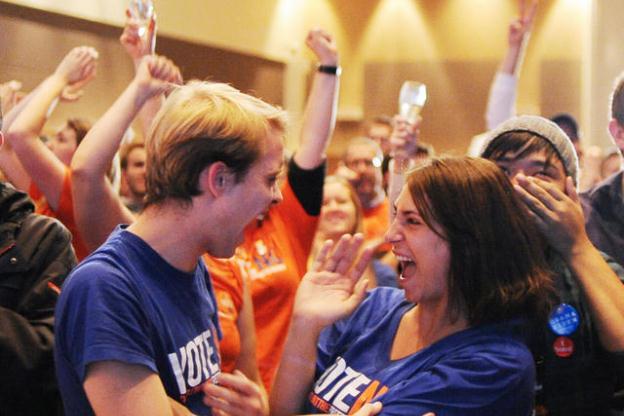
Marriage Equality in 2013: The Overview
The almost immediate calls for Marriage Equality Now! as a result of the election were met by the new DFL leadership in the legislature with a resounding “meh.”
For obvious reasons the first thing and really almost the only thing they have been talking about is the budget and taxes. This post is not meant to be a criticism of that budget first approach. Rather, the point of this post is to examine the chances of Marriage equality passing in this legislative session.
Before we get into that, I want to quickly discuss the reticence many feel about even trying for Marriage equality this session. Let’s not rush into things. In the meantime maybe the courts will decide that Marriage discrimination is unconstitutional and take it out of the legislatures hands entirely and wouldn’t that be swell?
These are things that are being said.
This timidness seems to comes from two places; uncertainty about what exactly the results of the election in regards to the Marriage amendment mean and a fear of the electoral consequences of voting for Marriage equality.
The first point regarding uncertainty of what the election results mean, was articulated rather well by Senate Majority leader designate Tom Bakk:
I think what the electorate was telling the Legislature is, ‘Don’t go pass constitutional amendments to get around a governor.’ You know, it was already against the law in Minnesota, there was no reason for a constitutional amendment, and I think most Minnesotans didn’t feel that amending the constitution with those kind of provisions — social provisions — was a proper use of the constitution.
There is evidence though, that Minnesotans are in fact supportive of Marriage equality to almost as much of a degree that they were opposed to the Amendment itself. Public Policy Polling’s last poll of the election came pretty close to nailing the final results of the Marriage amendment.
PPP (11/3, 10/8 in parenthesis, 9/12 in brackets):
Should the Minnesota Constitution be amended to provide that only a union of one man and one woman shall be valid or recognized as a marriage in Minnesota?
Yes 45 (46) [48]
No 52 (49) [47]
Not sure 3 (5) [5]
(MoE: ±2.9%)
The final results were, Yes 47%, No 51% (2% left blank). And it wasn’t just the Marriage amendment that they nailed in that poll, it was pretty much everything. But the Marriage question is what this post is concerned with.
In that same poll they asked a follow-up question:
PPP (11/3, 10/8 in parenthesis, 9/12 in brackets):
Do you think same-sex marriage should be legal or illegal?
Legal 49 (47) [43]
Illegal 41 (43) [46]
Not sure 10 (10) [11]
(MoE: ±2.9%)
The trend lines match up pretty well with the movement on the amendment question itself. The implication being that support for actual Marriage equality only runs a few points behind opposition to the amendment.
So with all due respect to Senator Bakk, the people of Minnesota were not only voting against the Marriage amendment on November 6th, they were voting for Marriage equality as well.
The other concern, the fear of electoral consequences concern is likely to be the larger issue.
As many have pointed out, a lot of DFLers come from districts that voted in favor of the Marriage amendment. To be specific, there are 10 such DFL Senators and 18 such DFL Representatives. And while those are not insignificant numbers not all of them will need to vote against their district, only some of them. And since there are just as many Republicans who represent districts that voted against the amendment a few might cross-over on a Marriage equality vote.
The following two tables show how many Senate and House districts voted for and against the amendment and what party represents those districts (when determining if a district voted yes or no I am not considering blanks, as this is meant to be a proxy for support or opposition to Marriage equality).
Senate Totals
|
House Totals
|
In both chambers of the Legislature, there is a majority of districts that voted against the amendment. And while this is a rather crude way of looking at things, it illustrates that though many DFLers may have a political problem voting for a Marriage equality bill, there may be just as many Republicans who have trouble voting against it.
Let’s assume that DFLers representing districts that voted against the amendment will likely vote for Marriage equality. And let’s also assume that Republicans representing districts that voted for the amendment will likely vote against equality.
If we assume these two things, than there are 18 Senators and 39 Representatives who could go either way. These are the in-betweeners.
In the Senate there are 29 DFLers who represent districts that voted against the amendment and it takes 34 votes in the Senate for a majority. That means five of the 18 in-betweeners in the Senate would need to decide in favor of equality.
In the House there are 55 DFLers who represent districts that voted against the amendment. It takes 68 votes in the House for a majority. That means 13 of the 39 in-betweeners in the House would need to decide in favor of equality.
The next two parts of this series will look at who these Senators and Representatives are and what we know or don’t know about their position on this issue.
Thanks for your feedback. If we like what you have to say, it may appear in a future post of reader reactions.


